Abstract
BACKGROUND:
Energy drinks contain stimulants mainly caffeine. The use of these drinks by university students is on the rise despite concerns about their safety. This study identified the determinants of the consumption of energy drinks in a cohort of Saudi university students.
MATERIALS AND METHODS:
This cross-sectional study was carried out at Imam Abdulrahman Bin Faisal University in Saudi Arabia. The students who volunteered to participate (n = 1255) were asked to complete a pretested questionnaire soliciting information on gender, marital status, class and college of study, pattern of energy drinks use, reasons for use, any benefits as well as any untoward effects experienced. Data was analysed using IBM-SPSS (version 21) to determine frequencies and compare various categories of the energy drink users. Logistic regression analysis were performed to identify determinants of energy drinks consumption.
RESULTS:
Out of 1255 participants, 245 reported using energy drinks. Out of a total 1255 students, 903 (72%) were from medical and 352 (28%) from nonmedical colleges of the university. There were 890 junior and 365 senior students. The female participants were significantly more among both senior and junior medical students. The age of the participants (mean ± SD) was 20.2 ± 1.9 years. The frequency of energy drinks users was higher in the male nonmedical students (both senior and junior) compared to the medical students. The most significant determinants identified were male gender (odds ratio [OR] 4.2, 95% confidence interval [CI] =3.34, 6.12), and being single (OR = 2.8, CI = 1.98, 4.24). In addition, being in non-medical field of study (OR = 1.3, 95% CI=0.61-2.13) was also found to have a reasonable association with energy drink consumption.
CONCLUSION:
We report male gender, unmarried status, and studying in nonmedical colleges of the university as the main determinants of the consumption of energy drinks by university students. Scrutiny of the patterns and reasons for the consumption of energy drinks might help in developing educational interventions to ensure the appropriate use of energy drinks by young adults.
Keywords: Caffeine, energy drinks, university students
Introduction
Beverages marketed as “energy drinks” contain stimulants, mainly caffeine and are marketed with the claims that they are mental and physical stimulants.[1] The average consumer is attracted by the unusual claims of increased energy, alertness, and sports performance. However, there is a genuine concern among the health professionals and authorities regarding the negative health impact of these products.[2]
The history of energy drinks can be traced to the initial marketing of “Pepsi” as energy booster in the early 20th century, the introduction of “Lucozade Energy” for hospital patients in the UK (1929), “Dr. Enuf” introduced in the USA (1949) and Lipovitan D introduced in Japan (1962).[3] The introduction of “Red Bull” in April 1987, and its subsequent aggressive marketing spread energy drinks all around the world.[4]
There are some safety concerns relating to the consumption of energy drinks and the claims of physiological and behavioral benefits.[5] There is evidence of adverse effects of high levels of caffeine in energy drinks on the cardiovascular system.[6] High caffeine consumption is known to have adverse effects including increase in blood pressure in susceptible individuals and sleep problems in adolescents. Likewise, in pregnancy, it increases the risk of late miscarriages, stillbirths, and small-for-gestational-age infants. Therefore, caution is advised against the consumption of high levels of caffeine in any form, especially in sensitive individuals.[7]
Energy drinks target mainly the age group of 18–35. In view of this, a number of studies have been carried out on the use of energy drinks by college and university students.[8] A few studies have been carried out in Saudi Arabia, but they mainly report the prevalence of energy drink use. These include the prevalence of 45.63% reported from Dammam,[5]59.9% from Jeddah,[9]52.2% from Madinah,[10]50.3% from Abha,[11]60% from Hail,[12] and 37.8% from Qassim[13] among others. Most of these studies reported higher frequency of the use of energy drinks in relation to such factors as male gender,[5,9,10,12,13] providing friends company/peer pressure,[5,13] the risk of hyperactivity/inattention,[11] living away from family,[11] examination stress,[9,11] smoking,[11,12] driving,[5,10,12] nonmedical colleges,[13] lack of awareness of the constituents[5] among many others. However, very few of these studies have tried to identify the determinants of the use of energy drinks by applying the relevant statistical analysis. Identification of determinants in the health-related issues is very important for the development of strategies for the education of people on precautions and preventives measures. The available literature points to a rise in the consumption of energy drinks by university students of Saudi Arabia. In this regard, there is a growing need to develop proper health-care advice on the consumption of energy drinks. This study was, therefore, carried out to identify the determinants of energy drink consumption by the students of a Saudi university.
Materials and Methods
This cross-sectional comparative study was carried out at Imam Abdulrahman Bin Faisal University from July to December 2017 with the approval of the Institutional Review Board (via IRB-UGS-2017-01-095). A questionnaire developed for a previous study[5] was deemed suitable by testing reliability (internal consistency/Cronbach's alpha = 0.86, test–retest reliability/Pearson's “r” =0.9) and validity (face validity: “it will work” and content validity ratio = 0.72 determined after evaluation by subject matter expert raters). The first set of questions was to identify demographic characteristics of the students including gender, marital status, age, exercise habits, own perception of health, and presence of any diagnosed disease. In addition, participants were asked about their college of study (categorized into medical and nonmedical students with the idea of testing the hypothesis that medical students will avoid a potentially hazardous drink) and class of study (Junior students were defined as the first three classes, and the seniors as the next classes, to test the hypothesis that seniors will consume less since they would be more aware of the health hazards of energy drinks). The second set of questions was about energy drinks consumption, age at the first use, reason for consumption at the first instance, reasons for continued use, usual time of the day it is consumed, favorite brand, average number of cans of drinks consumed in a week, maximum number of cans ever consumed in a single day, benefits experienced, untoward effects experienced, any physical or psychological effect of unavailability of energy drinks, trust in the efficiency of energy drink, and the urge to stop consuming energy drinks. In addition, awareness of the composition of energy drinks and recommendation of health authorities on the usage of these drinks was determined.
The students of the university were asked to volunteer for the study through their university E-mails and informed written consent was obtained from all participants. A total of 1255 students agreed to participate and complete the questionnaire. Based upon this, a post hoc calculation of sample size for “energy drink users” of the participants was done in order to identify the determinants of energy drinks consumption. A sample size of 222 energy drinks users was calculated based upon the total number of participants (n = 1255), confidence level of 95%, acceptable margin of error of 5, and expected response distribution of 46.5% (prevalence of energy drink usage by the students of the same university determined in a previous study).[5]
The data were entered into IBM-SPSS (version 21). Descriptive statistics were used to calculate frequency for categorical data and means (and standard deviation [SD]) for numerical data. Inferential statistics (t-test to compare means and Chi-square for proportions) were used to compare the results of junior and senior, medical and nonmedical, and male and female students. Stepwise logistic regression was applied to the variables showing significant association with energy drink consumption. Odds ratio (OR) and confidence interval were reported. The accepted significance was P < 0.05 (95% confidence level [CI]).
Results
The actual number of consumers among the participants (n = 1255) turned out to be 249 as against the calculated sample size of 222. As this did not need additional resources, the results of this study were based upon responses of 249 energy drinks users. The data of nonusers (n = 1006) was used for analysis leading to identification of the determinants.
Table 1 shows the baseline characteristics of the participants, grouped into junior and senior, medical and nonmedical, and male and female students. Out of a total 1255 students, 903 (72%) were from medical and 352 (28%) from nonmedical colleges of the university. There were 890 junior and 365 senior students. The female participants were significantly more among both senior and junior medical students. The age of the participants (mean ± SD) was 20.2 ± 1.9 years. The frequency of energy drinks users was higher in the male nonmedical students (both senior and junior) compared to the medical students. However, the usage was more in the female medical students compared to the nonmedical students.
Table 1.
The baseline characteristics for senior and junior, medical and nonmedical responders (n=1255)
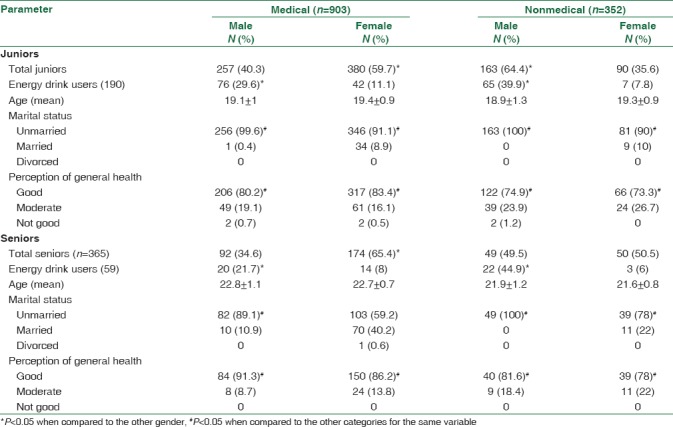
Table 2 presents data on the comparison of energy drink consumers with reference to seniority in relation to medical and nonmedical field of study, gender, marital status, and perception of health. The frequency of energy drink consumption was higher in unmarried students who perceived themselves as being in good health.
Table 2.
Comparison of energy drinks usage between junior and senior students in relation to gender, marital status, and general health (n=249)
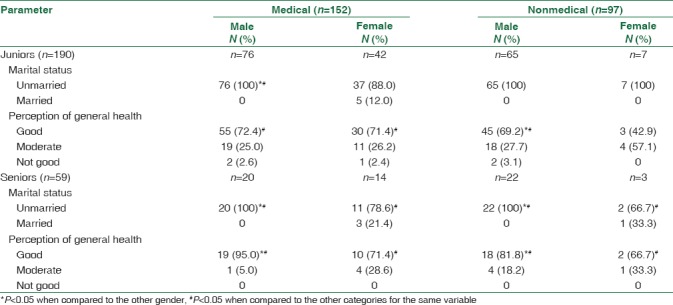
The characteristics of consumption by junior and senior students, respectively, are shown in Tables 3 and 4. The most frequent characteristics of usage were “no specific time for usage,” “no specific reason for the first time use” (the senior medical females consumed most frequently during examinations only), “occasional usage,” and “maximum 1–2 cans per day.” The most favorite brand consumed by males was “Code Red” and “Red Bull” by the females.
Table 3.
Comparison of energy drinks consumption between junior medical and nonmedical students (n=190)
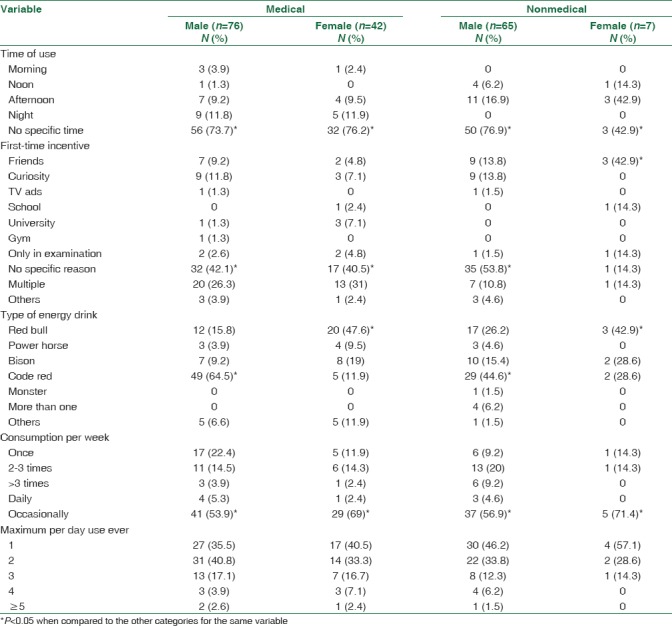
Table 4.
Comparison of energy drinks consumption between senior medical and nonmedical students (n=59)
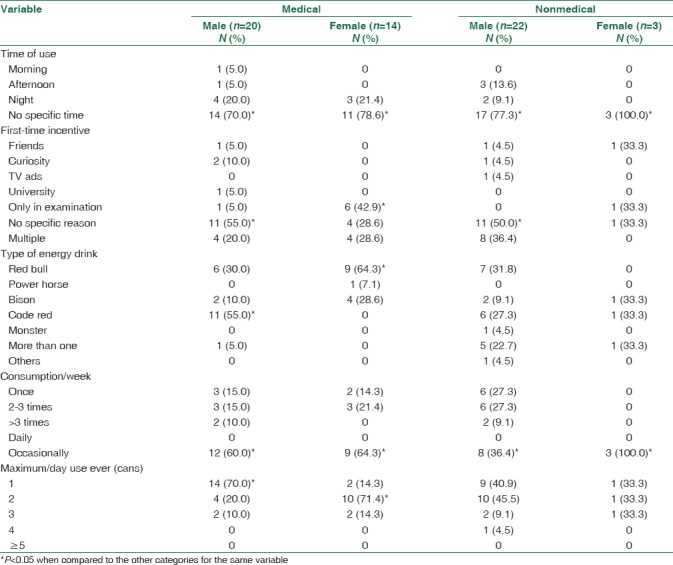
The reasons for consuming energy drinks were “to keep friends company” (26.1%) and “to keep awake” (23.3%) [Table 5]. The most common benefits of energy drinks reported by students was “Ability to stay awake” (61.4%), followed by “Improved alertness and attention” (57%) and “Increased physical activity” (53%) [Table 6]. Table 7 summarizes the untoward effects experienced by the energy drinks consumers. Most consumers experienced nothing (52.6%), while arrhythmias (26.1%), insomnia (23.3%), and increased urination (21.7%) were the common side effects experienced.
Table 5.
Reasons for consuming energy drink reported by the users (n=249)
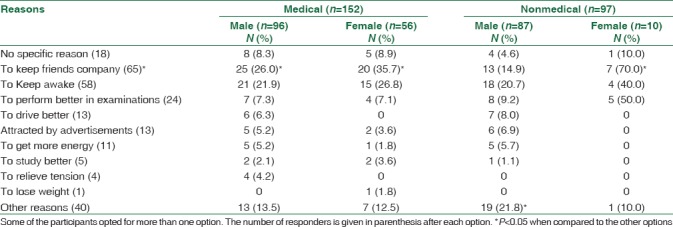
Table 6.
Benefits of energy drinks experienced by the users (n=249)

Table 7.
Side effects of energy drink experienced by the users (n=249)
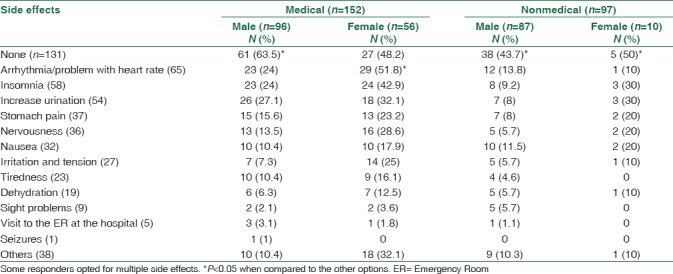
Table 8 presents the results of logistic regression analysis to identify the determinants of the consumption of energy drinks. Male gender (OR: 4.2, CI: 3.3–6.1), studying in nonmedical fields (OR: 1.3, CI: 0.61–2.13), and being single (OR: 2.8, CI: 1.98–4.24) were the most significant determinants of energy drinks consumption.
Table 8.
Logistic regression for determinants of energy drinks consumption (total subjects: 1255, energy drinks users 249)

Discussion
The aim of this study was to identify determinants of the consumption of energy drinks in a cohort of Saudi University students. The most significant determinants identified were male gender, nonmedical field of study and being single.
In our study, a significantly higher proportion of male students reported that they consumed energy drinks. A number of studies have reported similar findings.[14,15] The preponderance of males has been reported by many Saudi studies as well.[9,16,17] In our opinion, the most probable reason for this is the general attitude of young male students of taking more risks, getting involved in more physical activity, more peer pressure, careless behavior, and leaving examination preparation to the last minute adding to the stress.
A study from Abha in Saudi Arabia correlated behavior symptoms in male and female students of hyperactivity/inattention with the consumption of energy drinks. Bivariate regression analysis showed a significant association of the consumption of energy drinks with the risk of hyperactivity/inattention (OR = 2.47. 95% CI = 1.61, 3.78). The association with male gender in this study was also significant (OR = 1.334, 95% CI = 0.890–1.999]. However, the study did not find any association of the level of study with energy drinks consumption (OR = 0.910, 95% CI 0.990–1.047).[11]
A study from Jeddah reported that the consumption of energy drinks was associated with male gender (OR = 1.56; 95% CI: 1.11–2.2), studying in private colleges (χ2= 4.32, P < 0.05), and smoking (OR = 4.0, 95% CI: 2.58–6.15).[17] Likewise, a study from Hail in Saudi Arabia determined the association of consumption of energy drinks with socioeconomic status and lifestyle behaviors. There was a significant association of the consumption of energy drinks with smoking (OR = 2.243), irregular sleep (OR = 1.616), poor breakfast (OR = 1.161, and the expenditure of > 1000 SAR/month.[12]
University students are the target age of the marketing campaigns that showcase and sponsor sports, racing, and athletic events to which adolescents have free access.[18] The students of nonmedical colleges of the university in our study consumed more energy drinks. This was probably because medical students had more knowledge of the potential effects and side effects of different substances than students in nonmedical colleges. The first evidence for this is that consumption of energy drinks by seniors in nonmedical colleges is more than their juniors. The consumption might be more by junior medical students as they are likely to have relatively less scientific knowledge and less exposure to health awareness campaigns compared to their senior colleagues. The second evidence in support of this argument is that more medical students (62.9%) in our study had knowledge about the constituents of energy drinks compared with the nonmedical students (25%). Our result is in contrast to a study from Istanbul in which the medical students had very little knowledge of energy drinks and their side effects.[14] This reflects more general awareness about energy drinks.
Several studies in the USA and European countries have associated the consumption of energy drinks with the consumption of alcohol. A study correlated the consumption of energy drinks with some behavior problems in university students in an urban setting. They reported that energy drink consumption was significantly related with alcohol intoxication and driving (r = 0.14, P = 0.05). It was also correlated to riding with a drunk driver (r = 0.15, P = 0.05). However, the report stated that the consumption of energy drinks was not correlated to sports-related risks, use of tobacco, or illicit drugs.[19]
Another US study found positive correlations between the perceived stress in the participants and the consumption of energy drinks. This was, however, negatively correlated with academic performance. In the same study, freshmen and sophomores had consumed less energy drinks in the immediate past compared with junior students. Likewise, male students consumed more than females.[20] On the other hand, the junior students in our study appeared to consume more energy drinks. The probable reason given by Pettit and DeBarr in their study was that work for the senior students was more stressful, while we think our junior students consume more because they are not aware of the adverse effects of energy drinks, effects that they come to know later through health awareness campaigns as well as interaction with other student consumers.
Among the benefits experienced by the consumers, “ability to stay awake longer at night” was the overall most common. The females in the nonmedical group selected “increased physical activity” as the first choice followed by “improved alertness and attention.” In a previous study, “ability to stay awake longer” followed by “increased alertness” were the most common benefits indicated.[5] In a study from the Rabigh University in Saudi Arabia “enjoyment” was the most common benefit reported by all the students except by those of the preparatory years, most of whom answered “no benefit.”[21] Interestingly, in a study carried out in Hail, the “taste” was the topmost reason, probably because only 20% students were in higher education while the rest were of school age.[12] In another study, 25.6% of the students at Taibah University indicated “increased vitality” and 20.8% “alertness” as the benefits.[10]
In the current study, most (52.61%) consumers reported no adverse effect of the energy drinks. This figure was lower (30.62%) in a previous study.[5] Increased urination, insomnia, abnormal heart rhythm, and irritability were the most frequent adverse effects in both the studies. In the University of Rabigh study, most students reported no adverse effects. As in our study, the most common effects were increased urination, followed by palpitations.[21] Caffeine is linked to a number of adverse health effects in susceptible individuals including increased blood pressure and insomnia among other possible cardiovascular effects.[6] High caffeine intake during pregnancy has been reported to be associated with late abortions, babies with low birth weight, and stillbirths.[7] In addition, caffeine can cause palpitations, irritability, insomnia, anxiety and stomach complaints in susceptible individuals.[22] Caffeine also has a diuretic effect and can, therefore, cause dehydration.
The attraction of students toward the energy drinks can be compared with consumption of coffee in previous generations by university students. A significant majority of students in our study did not know about the recommendations by health authorities on the consumption of energy drinks. In our study, 44.1% of energy drinks consumers had the intention of stopping consuming energy drinks. This result is less than what was reported in a study carried out at Qassim University (55.1%).[13]
The limitations of this study are that owing to the constraints of the study design, the side effects attributed to the consumption of energy drinks could not be confirmed. Likewise, despite random sampling, there was a preponderance of female responders in the medical group.
Conclusion
Based upon the results of descriptive analysis for the variables that showed a preponderance of users, we report in this study, a strong association of male gender, unmarried status, and studying in nonmedical colleges of the university as the main determinants of the consumption of energy drinks. Scrutiny of the patterns and reasons for energy drink consumption might help in the development of educational interventions to ensure the appropriate use of energy drinks by young adults.
Financial support and sponsorship
Approved by the IRB of Imam Abdulrahman Bin Faisal University as an unbudgeted project (IRB-UGS-2017-01-095).
Conflicts of interest
There are no conflicts of interest.
Acknowledgment
We want to acknowledge the help of the female students (Azzahraa Abdulaziz AlAhmed, Fatimah Nabeel AlDandan, Sarah Ahmed Al Dawood, Fatimah Lateef Alkhabbaz, Nabaa Hisham Alhawashim and Fatimah Mohammed Alhaddad) who helped in data collection.
References
- 1.Aslam HM, Mughal A, Edhi MM, Saleem S, Rao MH, Aftab A, et al. Assessment of pattern for consumption and awareness regarding energy drinks among medical students. Arch Public Health. 2013;71:31. doi: 10.1186/2049-3258-71-31. [DOI] [PMC free article] [PubMed] [Google Scholar]
- 2.Clauson KA, Shields KM, McQueen CE, Persad N. Safety issues associated with commercially available energy drinks. J Am Pharm Assoc (2003) 2008;48:e55–63. doi: 10.1331/JAPhA.2008.07055. [DOI] [PubMed] [Google Scholar]
- 3.History of Energy Drink Usage. [Last accessed on 2018 Jun 01]. Available from: https://www.en.wikipedia.org/wiki/Energy_drink#History .
- 4.Watson S. How do Energy Drinks Work? 2006. [Last accessed on 2018 Jun 01]. Available from: http://www.science.howstuffworks.com/innovation/edible.innovations/energy-drink.htm .
- 5.Alsunni AA, Badar A. Energy drinks consumption pattern, perceived benefits and associated adverse effects amongst students of university of Dammam, Saudi Arabia. J Ayub Med Coll Abbottabad. 2011;23:3–9. [PubMed] [Google Scholar]
- 6.Arria AM, Bugbee BA, Caldeira KM, Vincent KB. Evidence and knowledge gaps for the association between energy drink use and high-risk behaviors among adolescents and young adults. Nutr Rev. 2014;72(Suppl 1):87–97. doi: 10.1111/nure.12129. [DOI] [PMC free article] [PubMed] [Google Scholar]
- 7.Arria AM, O'Brien MC. The “high” risk of energy drinks. JAMA. 2011;305:600–1. doi: 10.1001/jama.2011.109. [DOI] [PMC free article] [PubMed] [Google Scholar]
- 8.Malinauskas BM, Aeby VG, Overton RF, Carpenter-Aeby T, Barber-Heidal K. A survey of energy drink consumption patterns among college students. Nutr J. 2007;6:35. doi: 10.1186/1475-2891-6-35. [DOI] [PMC free article] [PubMed] [Google Scholar]
- 9.Alrasheedi AA. Prevalence and reasons for consumption of energy drinks among adolescents and young adults in Jeddah, Saudi Arabia. Global J Health Sci. 2016;9:23–8. [Google Scholar]
- 10.Aluqmany R, Mansoor R, Saad U, Abdullah R. Consumption of energy drinks among female secondary school students, Almadinah Almunawwarah, Kingdom of Saudi Arabia, 2011. J Taibah Univ Med Sci. 2013;8:60–5. [Google Scholar]
- 11.Alsamghan AS, Bharti RK, Alshbqe AA, Alahmari RM, Alqahtani AS, Ayidh FA, et al. Energy drinks consumption and its relationship with hyperactivity/inattention behaviour among the intermediate and high school male and female students. J Evid Based Med Healthc. 2016;3:4081–6. [Google Scholar]
- 12.Epuru S, Al-Shimmari S, Al-Shimmari E. Alarming high levels of energy drinks consumption among school children in Hail, Northern of Saudi Arabia. Int J Child Health Nutr. 2015;4:1–13. [Google Scholar]
- 13.Alrasheedi AA, Mozah AA, Alharbi OH, Alghadouni SA, Alfreedy MS, Alfawzan AI. Use of energy drinks by male students of Qassim University, Saudi Arabia. Int J Commun Med Public Health. 2017;3:1229–34. [Google Scholar]
- 14.Hidiroglu S, Tanriover O, Unaldi S, Sulun S, Karavus M. A survey of energy-drink consumption among medical students. J Pak Med Assoc. 2013;63:842–5. [PubMed] [Google Scholar]
- 15.Azagba S, Langille D, Asbridge M. An emerging adolescent health risk: Caffeinated energy drink consumption patterns among high school students. Prev Med. 2014;62:54–9. doi: 10.1016/j.ypmed.2014.01.019. [DOI] [PubMed] [Google Scholar]
- 16.Musaiger A, Zagzoog N. Knowledge, attitudes and practices toward energy drinks among adolescents in Saudi Arabia. Glob J Health Sci. 2013;6:42–6. doi: 10.5539/gjhs.v6n2p42. [DOI] [PMC free article] [PubMed] [Google Scholar]
- 17.Ibrahim NK, Iftikhar R, Murad M, Fida H, Abalkhaeil B, Al Ahmadi J. Energy drinks consumption amongst medical students and interns from three colleges in Jeddah, Saudi Arabia. J Food Nutr Res. 2014;2:174–9. [Google Scholar]
- 18.Seifert SM, Schaechter JL, Hershorin ER, Lipshultz SE. Health effects of energy drinks on children, adolescents, and young adults. Pediatrics. 2011;127:511–28. doi: 10.1542/peds.2009-3592. [DOI] [PMC free article] [PubMed] [Google Scholar]
- 19.Spierer DK, Blanding N, Santella A. Energy drink consumption and associated health behaviors among university students in an urban setting. J Community Health. 2014;39:132–8. doi: 10.1007/s10900-013-9749-y. [DOI] [PubMed] [Google Scholar]
- 20.Pettit ML, DeBarr KA. Perceived stress, energy drink consumption, and academic performance among college students. J Am Coll Health. 2011;59:335–41. doi: 10.1080/07448481.2010.510163. [DOI] [PubMed] [Google Scholar]
- 21.Murad HA, Rafeeq MM. Pattern of use and awareness of contents, benefits and adverse effects of energy drinks among university students in Rabigh, Saudi Arabia. Biomed Res. 2016;27:458–64. [Google Scholar]
- 22.McCusker RR, Goldberger BA, Cone EJ. Caffeine content of energy drinks, carbonated sodas, and other beverages. J Anal Toxicol. 2006;30:112–4. doi: 10.1093/jat/30.2.112. [DOI] [PubMed] [Google Scholar]


